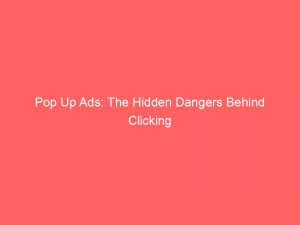Are pop-up ads the bane of your internet browsing experience? Imagine this: you’re innocently surfing the web, exploring your favorite sites, and suddenly – BAM!
– a flood of intrusive advertisements invades your screen. Annoying, right?
Well, fear not. In the battle against these pesky distractions, Microsoft Edge emerges as the hero, proudly blocking these pop-ups to save your sanity.
But what about Google Chrome? While it may be a bit susceptible to unwanted software and malware that unleash these irritating ads, fear not!
There are ways to combat them, shield yourself from their clutches, and restore serenity to your browsing journey. Join us as we delve into the world of pop-up ads and discover how to overcome their intrusion.
Table of Contents
- pop up ads
- 1) Microsoft Edge’s Pop-Up Ad Blocking Feature
- 2) Types Of Pop-Ups On Web Pages
- 3) Helpful Vs Distracting/Malicious Pop-Ups
- 4) Unwanted Software And Pop-Up Ads In Google Chrome
- 5) Tips For Avoiding Unwanted Software And Secure Browsing
- 6) Blocking Or Allowing Pop-Ups And Changing Ad Permissions In Chrome
- 7) Manual Removal Of Unwanted Programs On A Mac
- 8) Resetting Browser Settings And Turning On Trusted Extensions In Chrome
pop up ads
Pop-up ads are a type of advertisement that can appear on web pages, either being helpful or distracting/malicious. Microsoft Edge includes a feature that blocks pop-up ads, providing an improved browsing experience.
However, in Google Chrome, pop-up ads can be caused by unwanted software or malware, resulting in various issues. To avoid such problems, it is crucial to practice secure browsing and take necessary precautions.
Google Chrome offers options to block or allow pop-ups, and change ad permissions. In case of unwanted programs on a Mac, manual removal steps can be followed.
Resetting browser settings in Chrome and enabling trusted extensions can also help. For additional information and tips, the Google Chrome Privacy Whitepaper and Chrome Help Forum provide valuable insights.
Key Points:
- Pop-up ads can be helpful or distracting/malicious on web pages.
- Microsoft Edge blocks pop-up ads for an improved browsing experience.
- Google Chrome may have pop-up ads caused by unwanted software or malware.
- Secure browsing and necessary precautions are important to avoid issues.
- Google Chrome has options to block or allow pop-ups and change ad permissions.
- Manual removal steps can be followed for unwanted programs on a Mac.
Sources
https://support.google.com/chrome/answer/2765944?hl=en&co=GENIE.Platform%3DDesktop
https://support.microsoft.com/en-us/microsoft-edge/block-pop-ups-in-microsoft-edge-1d8ba4f8-f385-9a0b-e944-aa47339b6bb5
https://www.hellotech.com/blog/what-causes-pop-up-ads-how-to-remove
https://www.lifewire.com/how-to-stop-pop-ups-on-windows-10-4582598
Check this out:
💡 Pro Tips:
1. Install an ad blocker extension: In addition to Microsoft Edge’s built-in pop-up blocker, consider installing an ad blocker extension in your browser for extra protection against pop-up ads. These extensions can effectively block not only pop-ups but also other types of intrusive advertisements.
2. Keep your browser and security software up to date: Regularly updating your browser and antivirus or anti-malware software can help protect your device against not only pop-up ads but also various other online threats. These updates often include bug fixes and security patches that can prevent malicious pop-ups from appearing.
3. Be cautious when downloading software: Many pop-up ads that appear on websites offering free software downloads can be deceiving. Often, these pop-ups lead to installing unwanted software or malware on your device. Always exercise caution and verify the legitimacy of the website before downloading any software.
4. Enable pop-up blockers in other browsers: If you use a different browser than Microsoft Edge, such as Firefox or Safari, make sure to activate the built-in pop-up blocker feature. Each browser will have slightly different settings, but you can usually find the option to enable pop-up blocking in the browser’s settings or preferences menu.
5. Use a virtual private network (VPN) for added security: A VPN can help protect your online privacy and security by encrypting your internet connection and hiding your IP address. By using a VPN, you can reduce the chances of encountering pop-up ads that may be specifically targeted based on your browsing habits or location.
1) Microsoft Edge’s Pop-Up Ad Blocking Feature
Microsoft Edge, the web browser developed by Microsoft, comes equipped with a powerful feature that blocks pop-up ads. This feature is designed to enhance the browsing experience and ensure that users are not bombarded with intrusive advertisements while browsing the internet.
By default, Microsoft Edge blocks most pop-ups, providing a seamless and interruption-free browsing experience.
2) Types Of Pop-Ups On Web Pages
Pop-ups are small windows that appear on top of a webpage and can include a variety of content such as advertisements, notices, offers, or alerts. They can be triggered by certain actions on a webpage, such as clicking a link or submitting a form.
While some pop-ups can be useful and provide important information, others can be distracting or even malicious in nature.
3) Helpful Vs Distracting/Malicious Pop-Ups
Helpful Pop-ups: Some pop-ups serve a purpose and provide valuable information to users. For example, a website may display a pop-up informing users about a limited-time sale or offering a discount code.
These pop-ups can be helpful in guiding users through a website or providing relevant information.
Distracting/Malicious Pop-ups: On the other hand, there are pop-ups that are designed purely for advertising purposes and can be highly distracting. These pop-ups often appear without any user interaction and can be difficult to close, causing frustration and annoyance.
Moreover, some pop-ups can be malicious and may contain malware or lead to phishing websites, posing a serious threat to the security of users’ devices.
4) Unwanted Software And Pop-Up Ads In Google Chrome
Google Chrome, another widely used web browser, may sometimes display pop-up ads due to the presence of unwanted software or malware on a user’s computer. These unwanted programs can modify browser settings and inject advertisements into web pages, disrupting the browsing experience.
It is crucial to keep the browser and the operating system up to date and to maintain robust security software to minimize the risk of encountering such issues.
5) Tips For Avoiding Unwanted Software And Secure Browsing
6) Blocking Or Allowing Pop-Ups And Changing Ad Permissions In Chrome
In Google Chrome, users have the ability to control how pop-ups are handled and modify ad permissions. You can follow these steps to block or allow pop-ups and manage your ad settings:
-
Open Chrome and click on the three-dot menu in the top-right corner.
-
Select “Settings” from the drop-down menu.
-
Scroll down and click on “Privacy and security” in the left-hand sidebar.
-
Under the “Privacy and security” section, click on “Site settings.”
5.
Scroll down and click on “Pop-ups and redirects.”
6. Here, you can toggle the switch to block or allow pop-ups as per your preference.
-
To manage ad permissions, click on “Ads” under the “Privacy and security” section.
-
Adjust the toggle switches to control personalized ads and other ad-related settings.
7) Manual Removal Of Unwanted Programs On A Mac
If you are using a Mac and encounter unwanted programs that cause pop-up ads, you can manually remove them by following these steps:
-
Open the “Finder” application.
-
Click on “Applications” in the left-hand sidebar.
-
Locate the unwanted program that is causing the pop-up ads.
-
Drag the program to the “Trash” icon on the dock.
-
Right-click on the “Trash” icon and select “Empty Trash” to permanently remove the program.
8) Resetting Browser Settings And Turning On Trusted Extensions In Chrome
If you are still experiencing issues with pop-up ads or unwanted software in Google Chrome, you can try resetting the browser settings and turning on trusted extensions. To do so, follow these steps:
-
Open Chrome and click on the three-dot menu in the top-right corner.
-
Select “Settings” from the drop-down menu.
-
Scroll down and click on “Advanced” at the bottom.
-
Under the “Reset and clean up” section, click on “Restore settings to their original defaults.”
5.
Confirm the action by clicking on “Reset settings.”
6. Additionally, make sure to only install trusted extensions from the Chrome Web Store.
To do this, go to the Chrome Web Store and carefully review the extensions before adding them to your browser.
In conclusion, while pop-up ads can sometimes be helpful, they can also be distracting or even malicious. It is important to take necessary precautions to avoid unwanted software and ensure secure browsing.
By utilizing the features provided by Microsoft Edge and Google Chrome, such as pop-up ad blocking and managing ad permissions, users can enhance their browsing experience and protect themselves from potential threats. Remember to stay vigilant and follow best practices for a safe and enjoyable online experience.
For more information, you can refer to the Google Chrome Privacy Whitepaper and Chrome Help Forum.












